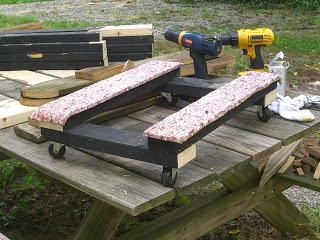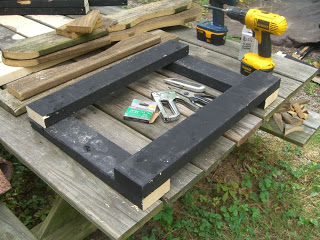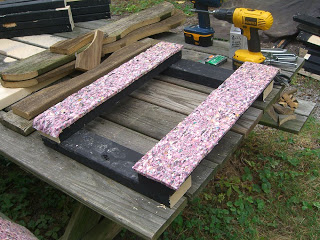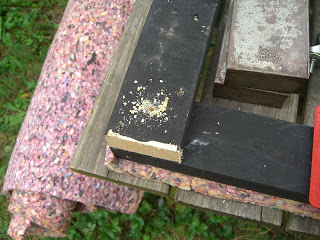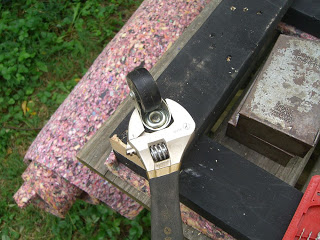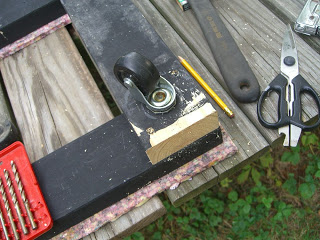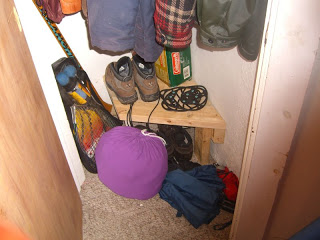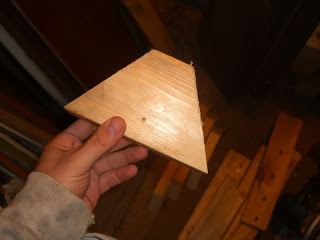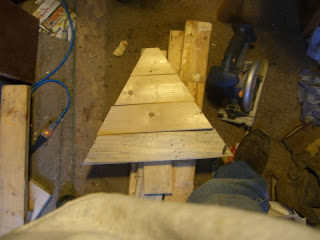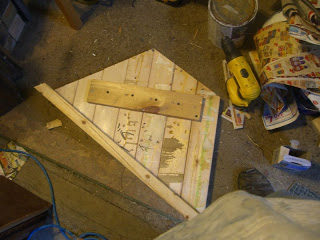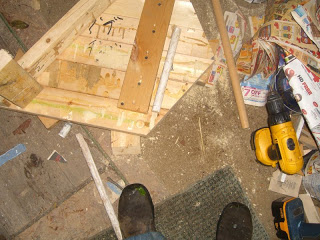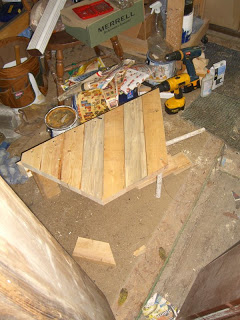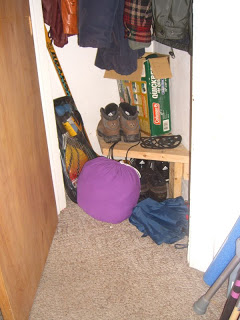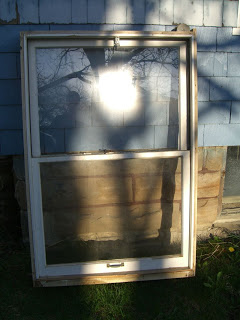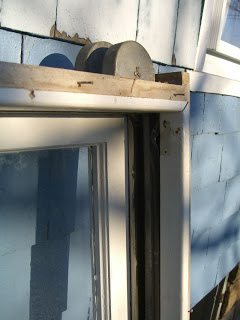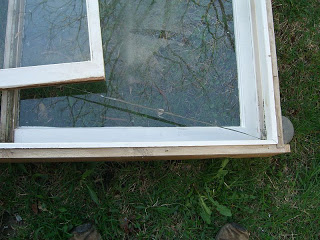Posts Tagged minor
One thing led to another…
Posted by aaron in tools and materials on 14 August 2012
I built a dolly:
- Box up books in one corner of living room. Consider placing them temporarily where the desk is currently located.
- Realize the bookshelves that are also coming from NY would fit well where the desk is, and decide to place something else in that space, something that will be gone before the shelves arrive.
- Decide to take all the stuff I agreed to store for someone for the month of August and put it in the place where the desk resides currently. Plan to move other things to the foyer where the stored stuff is currently.
- Realize all this is contingent on moving the desk.
- Remove everything from the corner where the desk will go.
- Empty desk drawers, clean top, finally unplug and put away various electronic devices atop the desk that are no longer being used.
- Find that desk is too heavy to move by myself.
- Mutter ‘I could do this if I had a dolly.’
- Decide to build a dolly.
- Get sidetracked for an hour sorting all the lumber I rescued from the theater festival strike by size, even though I only need four pieces of wood.
- Finally begin this fifteen minute construction project:
- 2x4s (I went with 2@18″ and 2@25″)
- four casters
- carpet padding or scrap carpet
- staple gun and staples
- 2.5″ screws
- power drill and bit set
Tea shelves
Today on Well That Was… An Idea… a good idea to turn scrap wood into a useful kitchen organizer.
We’ll be back after these commercials.
(That’s your clue to click on all the banner ads on this site and make me millions.)
So I had a cabinet full of boxes and bags of tea. I also had a small gap between a door and a cabinet, and plenty of scrap wood just waiting to be project-ed.
The second problem is you’ll want a peg that goes all the way through the cabinet wall and sinks into the board; much easier to achieve this with a screw or nail.
There’s actually a third difficulty if you’re going into artificial surfaces (like the heavy particleboard of these cabinets) – it’ll be almost impossible to drill a hole of the exact right size so the peg can be tapped in yet won’t slide out over time. Natural woods will be slightly more forgiving. Regardless of your woods, skip this approach and just use the screws.
Oh look, there’s a closet in here…
This is why I don’t write for the IKEA catalog. Anymore. Curse you, Lars…
Lets skip to the end for a moment. Here’s what I built:
The closet in my foyer is a small triangle, the result of doorways being re-positioned in the 50’s or earlier. Its size and shape make it so even a few items on the floor rapidly became a messy pile. It also presented an interesting planning challenge, namely figuring out the angle of the triangle’s apex so the shelf could fit as cleanly as possible into the back.
There’s probably a more technically-adept way of pursuing this, perhaps with calipers, or a degree in mathematics, but all my geometric scratchings just resulted in a worn pencil, so I went back to trial and error. I set the miter saw to what seemed like a good angle and made two cuts:
Then I trooped back and forth between the foyer and the workshop just fitting this one piece of wood into the back corner, and altering the angles needed until it fit ‘squarely’. I think I hit an acceptable fit on the third try – for many reasons, this is not an instance where extra time spent getting it justsoperfect gets you much of an improvement in end-quality.
With the angle noted, it was an easy job to knock out several more cuts using a tape measure and a combination square.
Same thing for the second grouping of boards, just without switching the miter back and forth:
This project was done mostly with two-by scrap for durability (how careful are you with the things you toss into the front hall closet?), because I had it around, and it’s easy to work with and forgiving (assuming you have an accurate enough saw). The rail is an easy cut since we already know the angle; I added a piece of scrap one-by to hold the stack together more cleanly.
The two-by rail could screw directly into the wall (if I knew where the studs were), but I went with a couple of simple legs made of two-by, and a ‘fancier’ leg cut from an old broomstick. Using a paddle bit, I set the leg about a half-inch into the shelf…
Then screwed in cleanly from the top:
Looks pretty, eh? This is why it’s nice to have piles of miscellaneous (sorted) fasteners, so you can find the right size and finish for the job.
Now I only planned on three legs – two two-bys on the long edge, and what turned out to be the broomstick – to maximize access under the shelf. I debated about the placement of the broomstick leg, ultimately deciding on the ‘front’ placement because I expected any unbalanced loads to be towards the front. Maybe this will prove completely wrong; if so, expect a lengthy report on the matter. In all likelihood, it won’t matter a lick – with the partial triangle shape, this is a stable design even though the leg isn’t placed at the center (if it was placed further ‘out’, tipping would be quite possible).
Next week: more projects that take longer to post than to complete.
So much for that schedule…
…which, I think, may already be the title of a similar post.
Hang on, I’ll check…
(flip, flip, flip)
(waiiiiit a minute, this isn’t on paper…)
Anyway, I have done many, many things on the house since the last post. No, really, you must believe me. What exactly, I can’t remember, because, you know – so many things! Yesterday I do remember. My friend Amanda wants to… learn about home repair? Is bored? Whatever the reason, she’s been asking to come over and help me on projects in exchange for food and drink, which is exactly in my price range dontchaknow. While the initial intent was to tackle getting the gutters back up, there’s still a bunch of pain in the neck prep work before we can even put the patches on the old holes, so I left that for the day.
Instead, we wound up rearranging a huge amount of stuff between the shed and the back room, freeing up tons of space, making tools accessible, and hitting upon the incredible conclusion that, of all the tools and materials that need to be in storage right now, that maybe that pile of plate glass panes that was in the shed could be what gets stored in the basement. You know, instead of anything wood or metal.
Geniuses, both of us.
Onwards!
Ceiling fan purchased…
Operation to commence tomorrow.
Hey here’s a good idea for homeowners
Posted by aaron in Uncategorized on 5 July 2011
No really, it’s one of those things that, if you haven’t done it already, you’ll smack your head when you read it:
Drill holes in the bottom of your garbage cans/recycling bins so rain can’t collect in them.
That’s it. I did this soon after moving into my house, although after one heavy rainstorm. It’s one of those things that you won’t notice the positive effects so much as you won’t notice the negative ones. Yes. Sentence structure.
For those craving specifics: I think I used a 3/4 inch spade bit on the recycling bins (our town uses 3 gallon buckets for recyclables), one hole dead center; and a 3/8″ or so bit several times on the bottom of the trash can. You shouldn’t be impacting the structural integrity of the can if you drill 2-3 holes spaced out from each other and avoiding any seams.
Today you may have seen me:
- Drilling holes in the bookcase beams
- Moving more gravel – I think it’s just about done
- Trimming a tree
More stuff
Posted by aaron in outside, tools and materials on 27 June 2011
A gravel expansion of angled parking spaces next to my still technically gravel driveway continued apace today. Details and pictures soon, when it’s complete. So maybe not so soon, really.
And also today, two revelations about mulberries:
1) They are delicious. I knew they were edible, and had even started looking up things one can make with them online, but hadn’t actually tried real nice ripe ones until today whilst wandering around the yard talking on the phone with an old friend.
2) They stain things. I knew they stained my hands and the tarps on which they’ve fallen over the last few years, but I just realized that maybe they could also stain wood. This could add an interesting, very purple, twist on projects in the future.
Related – noticed that the black walnut by the driveway is bearing fruit this year, so homemade stain plans are definitely back on the agenda for fall.
Spring balances – a note of caution
Posted by aaron in tools and materials on 30 September 2010
If you’ve skimmed this blog, you know I like salvaging old building materials for new projects. Such was the case with a set of 60s era windows, still in frames, out of a house up by the lake. Disassembling the frames to free up the sashes is pretty straightforward – you just need a little patience to separate the pieces without splitting to much of the wood. The reason for this post is just a bit of fair warning about the object on the top right of the frame in this picture:
These are spring balances – one per sash – a technology still very much in use today. They are just a strap wound and spring loaded in the case, and attached about a quarter of the way down each sash:
I’ve seen a few of these with rubber straps, but typically they are thin, flat metal. With very sharp edges. The safest way I found to approach these is to relieve the tension on the spring – free the sash from the frame and tilt it so the strap can retract almost all the way (see next to last photo). Then and only then should you try and release it from the hook inside the sash. Wear gloves (seriously) and safety goggles (no reason not to).
Removing old knob and tube porcelain fixtures
Posted by aaron in basement, electrical on 2 March 2010
This isn’t a post about replacing old wiring with new three strand Romex. (There will be posts on that, don’t you worry your pretty little heads.) No, this is a post about a seemingly small but very poorly documented task related to such replacements – removing the knob and tube porcelain fixtures themselves. Note: The following pictures are of completely dead, orphaned wiring segments – they have not been attached to the electrical panel for decades. Never muck with live wiring, especially live knob and tube.
The nail likely extends an inch or less into the beam:
Removing knobs, then, is a fairly straightforward matter of wedging a hammer between the beam and the porcelain, and levering the nail out using the entire fixture. This next picture doesn’t show how far I actually inserted the hammer – quite close to the nail:
I was a little unsure at the start of this project for fear of shattering porcelain everywhere. It doesn’t seem to be an issue – the porcelain will likely chip and flake, especially as you’re first working the hammer in behind the knob…
… but it’s stronger than you might think. A gentle-but-firm approach had a half-dozen knobs out in less than ten minutes, and even an overzealous pull on one resulting in it flying from the beam and clattering to the floor didn’t cause any of them to break.
